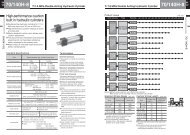70/140H-8 Series (2310KB) - TAIYO
70/140H-8 Series (2310KB) - TAIYO
70/140H-8 Series (2310KB) - TAIYO
Create successful ePaper yourself
Turn your PDF publications into a flip-book with our unique Google optimized e-Paper software.
27<br />
Selection materials<br />
Selection<br />
materials<br />
Example of calculation for selection<br />
< Answer ><br />
1. Find the inertia energy of load at the inrush into cushion, E1.<br />
Inertia energy in the case of linear movement, E1<br />
E1 = MV2 /2 = 500 × 0.32 < Example 1 ><br />
Cylinder <strong>70</strong>H-8 φ63<br />
Set pressure P1 = 5 MPa<br />
Load weight M = 500 kg<br />
Load speed V = 0.3 m/s (the speed at the inrush into<br />
cushion is 300 mm/s)<br />
Load moving direction<br />
Downward θ =30° (there is no external force applied<br />
to the cylinder other than gravity)<br />
Working direction<br />
Forward (the direction of the piston rod ejected from the<br />
cylinder)<br />
Gravitational acceleration g = 9.8 m/s<br />
/2 = 22.5J<br />
2<br />
Magnetic proximity type (with contact)<br />
2. Find the E2, energy generated by the external force F, applied to the cylinder at the inrush into cushion.<br />
2.1 Find the external force F, applied in the direction of the cylinder axis at the inrush into cushion.<br />
F = Mgsin θ = 500 × 9.8 × sin30° = 2450N<br />
2.2 Convert the external force F, found in the step 2.1, into the energy E2.<br />
In the “Chart of conversion of external force into energy at the inrush into cushion of <strong>70</strong>/<strong>140H</strong>-8”, find the<br />
cross point of the straight line from the point of 2450 N on the<br />
lateral axis F and the slant line shown in the chart. Then, draw a<br />
straight line from the cross point on the slant line parallel with the<br />
lateral axis until it reaches the longitudinal axis of the chart. The<br />
cross point 8.7 J, indicates the energy applied by the external force.<br />
E2 = 8.7J<br />
3. Find the maximum energy absorbed of the cylinder, Et.<br />
In the right chart, find the cross point of the straight line from the point<br />
of 5 MPa on the lateral axis, the set pressure of the “Maximum<br />
energy absorbed of cushion” of the <strong>70</strong>H-8 and the curve of φ63. Then,<br />
draw a straight line from the cross point on the curve parallel with the<br />
lateral axis until it reaches the longitudinal axis of the chart. The<br />
cross point, 44 J, indicates the maximum energy absorbed.<br />
Et = 44J<br />
4. Ensure that E1 + E2 is same as the maximum energy absorbed Et,<br />
or smaller.<br />
E1 + E2 = 22.5 + 8.7 = 31.2 J<br />
where, Et = 44J<br />
Therefore, the following condition is satisfied: E1 + E2 q Et.<br />
As a result, the cylinder is applicable.<br />
< Reference ><br />
In case that the load moving direction is horizontal and there is no external force applied (E2 = 0), from the set<br />
pressure, first find the maximum energy absorbed, Et. Then, the allowable load weight and allowable load<br />
speed can be found.<br />
To find the allowable load weight, M: M = 2Et/V2 To find the allowable load speed, V : V = √2Et/M<br />
Mg sinq<br />
q<br />
Energy E2<br />
Mg<br />
Maximum energy<br />
absorbed Et<br />
8.7<br />
J<br />
44<br />
J<br />
q=30°<br />
2450 N<br />
External force F applied during<br />
cushion stroke<br />
5MPa<br />
Set pressure P1<br />
φ63




